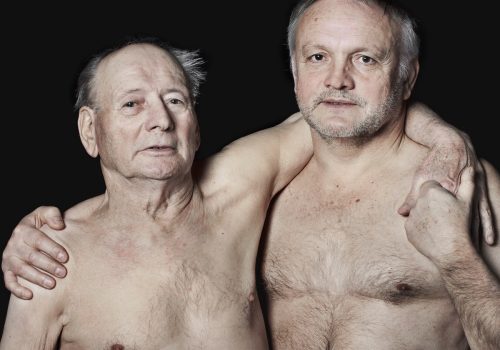The theme of the 41st Estivales places the paternal figure at the center of photographic questioning. Our fathers: the possessive induces that the point of view is collective and turned towards the preceding generations. Because if there is a father, there must necessarily be a child, and therefore a look at him. The eyes of the seven guest authors are unequivocal, all or almost all of them call their series “Father”. No frills, no adjectives, as a statement, however full of questions. What were our fathers? How were they?
And what is a father? Victor Hugo in The Legend of the Centuries describes it thus: The father is the blessed roof, the prosperous shelter, / A starlight through the cypresses, / It is the honor, it is the pride, it’s God we feel close to. This figure of omnipotence is that of the pater familias, an archetype inherited from ancient Rome and the foundation of our patriarchal societies. In this traditional conception, the father defines himself in a determined social role: he is the leader, having the right of life and death over his own. He is the one who has to support the family and transmit moral values. The questioning of this figure of authority, which is part of a societal re-examination of the concepts of masculinity and parenthood, redefines the role (s) of the father. By turning to this figure, the authors also question the notions of inheritance, model, commitment, link. The program offers a three-part journey that is articulated from the collective to the intimate, from societal history to individual fiction.
The works presented in Room 1 offer a collective look at several generations of fathers. Anne Delrez, Artistic Director of La Conserverie, is thus immersed in her collection of amateur family albums to extract a set of vernacular images that draw a father figure in representation. When he is photographed as a father, that is to say in the same frame as his children, he seems to play a role, showing once again how much photography is involved in the media construction of an archetype. Fully integrating into our contemporary era, Gregoire Korganow realizes the portrait of fathers and sons that disrupts our landmarks: the father is no longer an impalpable entity. He incarnates himself, with all the reality of his corporality, in all his materiality. The photographer reveals a disturbing intimacy and reinvents an iconography of paternity in which the transmission is also physical: an exchange, a primitive skin to skin contact.
In room 2, it is the figure of the father as a tutelary presence that is questioned by the two authors. Taysir Batniji photographed in Gaza the establishments in which are hung the photographic portraits of the founding fathers, “masters of the place”, who are seen as ghosts in the image. Pere Formiguera made a portrait of his own father every month for ten years. Pare seems nevertheless unalterable in the passage of time: he remains, mythified in its stripping (frontality, visceral frankness). Strangely, and even though the authors’ respective project is to observe their disappearance, the fathers strongly affirm their presence, a very ingrained presence, both benevolent and authoritarian. Fathers majestic monuments, in glory and glorified, but also already in decline.
The erasure of the figure of the pater familias at work at Batniji and Formiguera continues with the last body of authors, which unfolds in Room 3 of L’Imagerie and Chapel Saint-Samson. With Frédérique Aguillon, Quentin Yvelin and Colette Pourroy, who confront their origins by questioning their own father, the enigmas of personal stories emerge, and their mysterious filiations. To the multiplicity of identity that comes thru in the paternal figure observed by Frédérique Aguillon, the elusive elucubrator father seems to dress with as many costumes as there are dreamed lives, answers the father searching, captivated, the builder of Quentin Yvelin, as much in fusion with the elements than with the raw and granular material of the image. Most of the time, seen from the back, bodies fragmented or their eyes closed, these fathers are at the center and yet they escape. Between presence and absence, the father figure appears troubled this time – it is no longer in majesty. It eventually dissolves, liquefies in Colette Pourroy pictures, evoking it in hollow, in shadows and reflections, vaporous, in ghostly and moving presences. And if there also the father exists, it is according to the fictions of the child who looks at him or fantasize him, and thereby invents him.
41e Estivales Photographiques du Trégor – Nos Pères
June 22 to October 05
Frédérique Aguillon, Taysir Batniji, Pere Formiguera, Grégoire Korganow, Quentin Yvelin et La Conserverie
À L’Imagerie
19 rue Jean Savidan
22300 Lannion
June 22 to July 24, 2019Colette Pourroy
À la Chapelle Saint Samson
22560 Pleumeur-Bodou
















